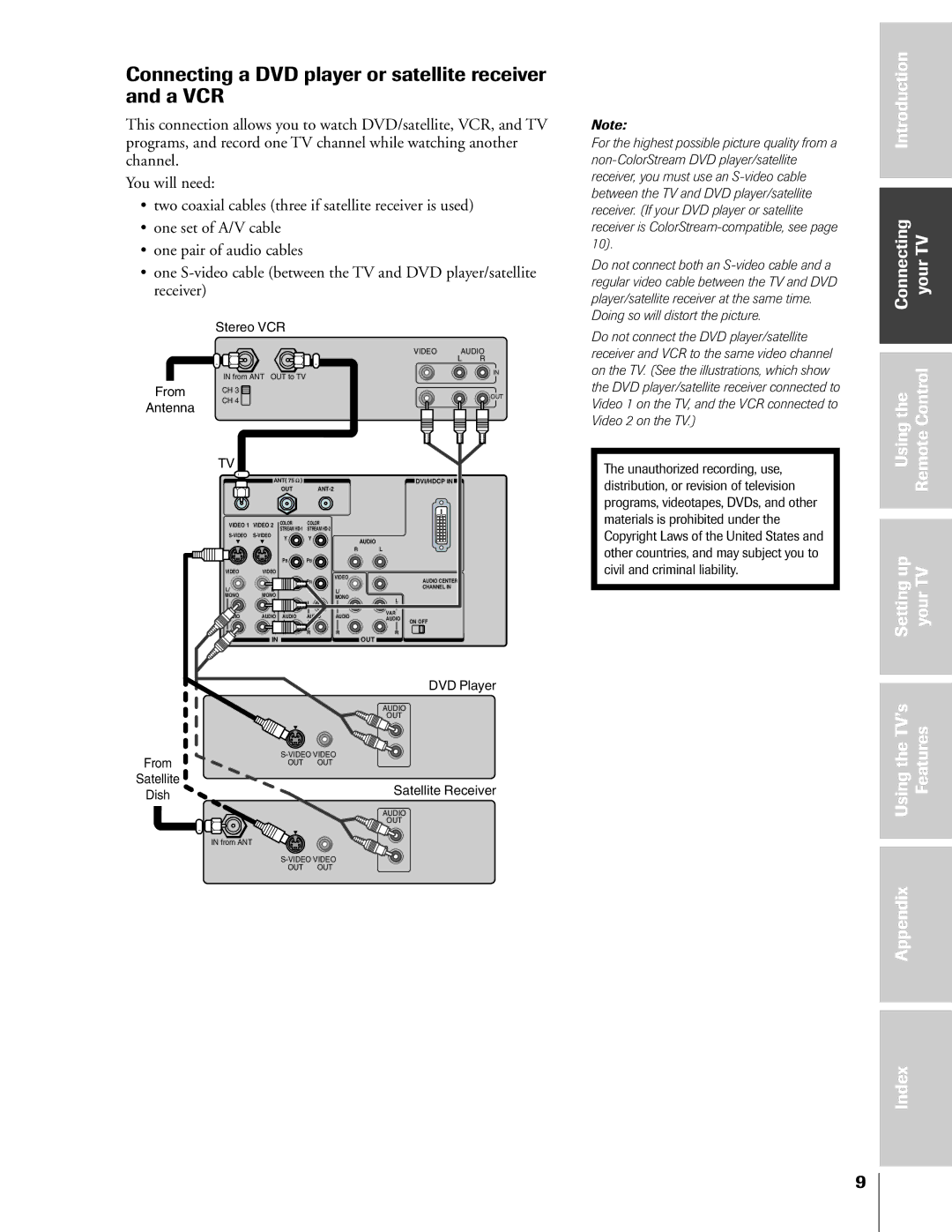
Connecting a DVD player or satellite receiver and a VCR
This connection allows you to watch DVD/satellite, VCR, and TV programs, and record one TV channel while watching another channel.
You will need:
¥two coaxial cables (three if satellite receiver is used)
¥one set of A/V cable
¥one pair of audio cables
¥one
Stereo VCR
|
|
|
|
|
|
| VIDEO | AUDIO |
|
|
|
|
|
|
|
| L R |
| IN from ANT OUT to TV |
|
|
|
| IN | ||
From |
|
|
|
|
| |||
CH 3 |
|
|
|
|
|
| OUT | |
Antenna | CH 4 |
|
|
|
|
|
|
|
|
|
|
|
|
|
|
| |
| TV |
|
|
|
|
|
|
|
|
| ANT( 75 ) |
|
|
| DVI/HDCP IN |
| |
|
| OUT |
|
|
|
| ||
| VIDEO 1 | VIDEO 2 | COLOR | COLOR |
|
|
|
|
|
|
| STREAM | STREAM |
|
|
|
|
| Y | Y |
| AUDIO |
|
| ||
|
|
|
|
|
| |||
|
|
|
|
|
|
|
| |
|
|
|
|
| R | L |
|
|
|
|
| PB | PB |
|
|
|
|
| VIDEO | VIDEO |
|
| VIDEO |
|
|
|
|
|
|
| PR |
| AUDIO CENTER |
| |
|
|
|
|
|
|
| ||
| L/ |
|
|
| L/ |
| CHANNEL IN |
|
| MONO | MONO |
|
|
|
|
| |
|
|
| MONO | L |
|
| ||
|
|
|
| L |
|
|
| |
|
|
|
|
|
|
|
| |
| AUDIO | AUDIO | AUDIO | AUDIO | AUDIO | VAR |
|
|
| AUDIO | ON OFF |
| |||||
|
|
|
|
|
|
| ||
|
|
|
|
|
|
|
| |
| R |
|
| R | R | R |
|
|
|
| IN |
|
|
| OUT |
|
|
|
|
|
|
|
|
| DVD Player | |
|
|
|
|
|
| AUDIO |
|
|
|
|
|
|
|
| OUT |
|
|
|
|
|
|
|
| L |
|
|
|
|
|
|
|
| R |
|
|
From |
|
|
|
|
| |||
|
| OUT | OUT |
|
|
|
| |
Satellite |
|
|
|
|
| Satellite Receiver | ||
Dish |
|
|
|
|
| |||
|
|
|
|
|
|
|
| |
|
|
|
|
|
| AUDIO |
|
|
|
|
|
|
|
| OUT |
|
|
|
|
|
|
|
| L |
|
|
| IN from ANT |
|
|
|
|
|
|
|
R
OUT OUT
Note:
For the highest possible picture quality from a
Do not connect both an
Doing so will distort the picture.
Do not connect the DVD player/satellite receiver and VCR to the same video channel on the TV. (See the illustrations, which show the DVD player/satellite receiver connected to Video 1 on the TV, and the VCR connected to Video 2 on the TV.)
The unauthorized recording, use, distribution, or revision of television programs, videotapes, DVDs, and other materials is prohibited under the Copyright Laws of the United States and other countries, and may subject you to civil and criminal liability.
Introduction |
|
|
|
|
|
Connecting | yourTV |
|
|
|
|
Usingthe | RemoteControl |
|
|
|
|
Settingup | yourTV |
|
|
|
|
UsingtheTVÕs | Features |
|
|
|
|
Appendix |
|
|
|
|
|
Index |
|
|
|
9
